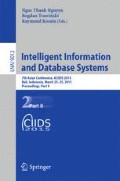Abstract
In the paper we present a method for usability evaluation of kinetic gesture based user interfaces with application of eye tracking. First we present the problems of the kinetic interaction and the application of eye tracking in usability studies. Then we present our method of the usability verification with applied eye tracking, by performing a sample experiment, then its results and discussion.
Access this chapter
Tax calculation will be finalised at checkout
Purchases are for personal use only
Preview
Unable to display preview. Download preview PDF.
References
Bruegger, P., Hirsbrunner, B.: Kinetic user interface: interaction through motion for pervasive computing systems. In: Stephanidis, C. (ed.) UAHCI 2009, Part II. LNCS, vol. 5615, pp. 297–306. Springer, Heidelberg (2009)
Chynał, P., Sobecki, J.: Comparison and analysis of the eye pointing methods and applications. In: Pan, J.-S., Chen, S.-M., Nguyen, N.T. (eds.) ICCCI 2010, Part I. LNCS, vol. 6421, pp. 30–38. Springer, Heidelberg (2010)
Chynał, P., Szymański, J.M., Sobecki, J.: Using eyetracking in a mobile applications usability testing. In: Pan, J.-S., Chen, S.-M., Nguyen, N.T. (eds.) ACIIDS 2012, Part III. LNCS, vol. 7198, pp. 178–186. Springer, Heidelberg (2012)
Duchowski, A.T.: Eye tracking methodology: Theory and practice, pp. 205–300. Springer-Verlag Ltd., London (2003)
Hayes, G.: 16 Top Augmenter Reality Business Models. A weblog by Gary Hayes posted at August 14 2009. Downloaded in October 2014 from http://www.personalizemedia.com/16-top-augmented-reality-business-models/
International Standard ISO 9241-11. Ergonomic requirements for office work with visual display terminals (VDTs) – Part 11: Guidance on Usability. ISO (1997)
Mohamed, A.O., Perreira Da Silva, M., Courbolay, V.: A history of eye gaze tracking (2007). http://hal.archivesouvertes.fr/docs/00/21/59/67/PDF/Rapport_interne_1.pdf (March 10 2014)
Pallotta, V., Bruegger, P., Hirsbrunner, B.: Kinetic User Interfaces: Physical Embodied Interaction with Mobile Pervasive Computing Systems. IDEA Group Publishing (2008)
Author information
Authors and Affiliations
Corresponding author
Editor information
Editors and Affiliations
Rights and permissions
Copyright information
© 2015 Springer International Publishing Switzerland
About this paper
Cite this paper
Szymański, J.M., Sobecki, J., Chynał, P., Anisiewicz, J. (2015). Eye Tracking in Gesture Based User Interfaces Usability Testing. In: Nguyen, N., Trawiński, B., Kosala, R. (eds) Intelligent Information and Database Systems. ACIIDS 2015. Lecture Notes in Computer Science(), vol 9012. Springer, Cham. https://doi.org/10.1007/978-3-319-15705-4_35
Download citation
DOI: https://doi.org/10.1007/978-3-319-15705-4_35
Published:
Publisher Name: Springer, Cham
Print ISBN: 978-3-319-15704-7
Online ISBN: 978-3-319-15705-4
eBook Packages: Computer ScienceComputer Science (R0)

